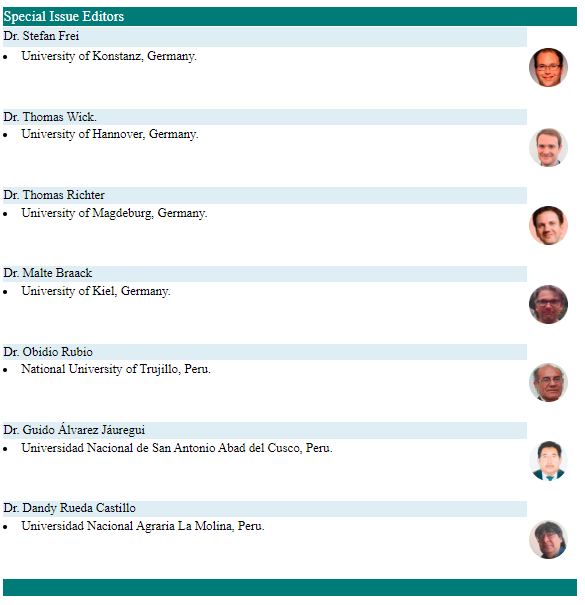Estabilidad de un modelo depredador-presa tipo Leslie Gower con un efecto Allee fuerte con retardo
DOI:
https://doi.org/10.17268/sel.mat.2022.01.02Palabras clave:
Efecto Allee, modelo depredador-presa tipo Leslie Gower, parametro de retardo, estabilidad, bifurcación de HopfResumen
En este trabajo se estudia un modelo depredador-presa del tipo Leslie-Gower modificado que introduce en el crecimiento de la población de presas un fuerte efecto Allee retardado.
El modelo Leslie-Gower con efecto Allee no tiene ninguno, uno o dos puntos de equilibrio positivos, pero la incorporación de un retardo temporal en la tasa de crecimiento desestabiliza el sistema, rompiendo la estabilidad cuando el retardo cruza un punto crítico. Se estudia en detalle la existencia de una bifurcación de Hopf y las simulaciones numéricas confirman los resultados teóricos mostrando los diferentes escenarios.
Presentamos interpretaciones biológicas para especies de tipo presa-predador
Citas
Aziz-Alaoui MA, Daher Okiye M. Boundedness and global stability for a predator-prey model with modified Leslie-Gower and Holling-type II schemes, Applied Mathematics Letters 2003; 16:1069-1075.
Bazykin AD. Nonlinear Dynamics of interacting populations, World Scientific 1998.
Berec L, Angulo E, Courchamp F. Multiple Allee effects and population management, Trends in Ecology and Evolution. 2007; 22:185-191.
Celik C. Hopf bifurcation of a ratio-dependent predator-prey system with time delay, Chaos, Solitons and Fractals. 2009; 42:1474-1484.
Clark CW. Mathematical Bioeconomics: The Mathematics of Management. (2nd ed), John Wiley and Sons Inc. 1990.
Courchamp F, Clutton-Brock T, Grenfell B. Inverse dependence and the Allee effect, Trends in Ecology and Evolution. 1999; 14:405-410.
Courchamp F, Berec L, Gascoigne J. Allee effects in Ecology and Conservation, Oxford University Press 2008.
Das K, Chakraborty M, Chakraborty K, Kar TK. Modelling and analysis of a multiple delayed exploited ecosystem towards coexistence perspective, Nonlinear Dynamics 2014; 78(1):505-523. DOI 10.1007/s11071-014-1457-3.
Freedman HI.Deterministic Mathematical Model in Population Ecology. Marcel Dekker; 1980.
Freedman HI, Rao VSH. The tradeoff between mutual interference and time lag in predator prey models., Bull. Math. Biol. 1983; 45:991-1004.
González-Olivares E, Mena-Lorca J, Rojas-Palma A, Flores JD. Dynamical complexities in the Leslie-Gower predator-prey model as consequences of the Allee effect on prey, Applied Mathematical Modelling. 2011; 35:366-381.
González-Olivares E, Mena-Lorca J, Rojas-Palma A, Flores JD. Erratum to “Dynamical complexities in the Leslie-Gower predator-prey model as consequences of the Allee effect on prey”. [Appl. Math. Modell. (2011) 366-381], Applied Mathematical Modelling. 2012; 36:860-862.
Ho C-P, Lin C-H, Huang H-N. On the Lyapunov functional of the Leslie-Gower predator-prey models with time-delay and Hollings’s functional response, Electronic Journal of Qualitative Theory of Differential Equations. 2012; 35:1-27.
Li Y, Li C. Stability and Hopf bifurcation analysis on a delayed Leslie-Gower predator-prey system incorporating a prey refuge, Appl. Math. and Comp. 2013; 219:4576-4589.
Liermann M, Hilborn R. Depensation: evidence, models and implications, Fish and Fisheries. 2001; 2:33-58.
Hale JK, Lunel SMV. Introduction to functional differential equations (Vol. 99). Springer Science and Business Media. 2013.
Kot M. Elements of Mathematical Ecology, Cambridge University Press 2001.
Kuang Y. Delay differential equations with applications in Populations Dynamics, Academic Press, Inc. 1993.
Kuang Y, Beretta E. Global qualitative analysis of a ratio-dependent predator-prey system, J. Mat. Biol. 1998; 36:389-406.
Kumar P, Raj S. Modelling and analysis of prey-predator model involving predation of mature prey using delay differential equations. Numerical Algebra, Control and Optimization. 2021.
Liu J. Bifurcation analysis in a stage-structured predator-prey model with maturation delay, Int.J. Mat. Biol. 2014, Vol 7(4):(1-17)
May RM. Stability and complexity in model ecosystems (2nd edition), Princeton University Press 2001.
Nindjin AF, Aziz-Alaoui MA, Cadivel M. Analysis of a predator-prey model with modified Leslie-Gower and Holling-type II schemes with time delay, Nonlinear Analysis: RealWorld Applications. 2006; 7:1104-1118.
Pal PJ, Saha T, Sen M, Banerjee M. A delayed predator-prey model with strong Allee effect in prey population growth, Nonlinear Dynamics 2011; 68(1):23-42.
Smith H. An Introduction to Delay Differential Equations with applications to the Life Sciences, Springer 2011.
Stephens PA, Sutherland WJ. Consequences of the Allee effect for behaviour, ecology and conservation. Trends in Ecology and Evolution. 1999; 14:401-405.
Stephens PA, Sutherland WJ, Freckleton RP. What is the Allee effect?, Oikos. 1999; 87:185-190.
Turchin P. Complex population dynamics. A theoretical/empirical synthesis, Monographs in Population Biology 35 Princeton University Press, 2003.
Xua R, Gan Q, Ma Z. Stability and bifurcation analysis on a ratio-dependent predator-prey model with time delay, J. Comput. Appl. Math. 2009; 230:187-203.
Yue Y, Lui H, Wei Y, Ma M, Zhang K. Dynamic study of a Predator Prey Model with Weak Allee Effect and Delay, A. Math. Physics. 2019; 2019:1-15.
Descargas
Publicado
Cómo citar
Número
Sección
Licencia
Derechos de autor 2022 Selecciones Matemáticas

Esta obra está bajo una licencia internacional Creative Commons Atribución 4.0.
Los autores/as que publiquen en esta revista aceptan las siguientes condiciones:
- Los autores/as conservan los derechos de autor y ceden a la revista el derecho de la primera publicación, con el trabajo registrado con la licencia de atribución de Creative CommonsAtribución 4.0 Internacional (CC BY 4.0) , que permite a terceros utilizar lo publicado siempre que mencionen la autoría del trabajo y a la primera publicación en esta revista.
- Los autores/as pueden realizar otros acuerdos contractuales independientes y adicionales para la distribución no exclusiva de la versión del artículo publicado en esta revista (p. ej., incluirlo en un repositorio institucional o publicarlo en un libro) siempre que indiquen claramente que el trabajo se publicó por primera vez en esta revista.
- Se permite y recomienda a los autores/as a publicar su trabajo en Internet (por ejemplo en páginas institucionales o personales) antes y durante el proceso de revisión y publicación, ya que puede conducir a intercambios productivos y a una mayor y más rápida difusión del trabajo publicado(Consultar: efecto del acceso abierto).













